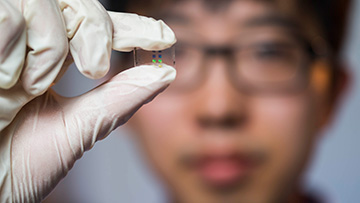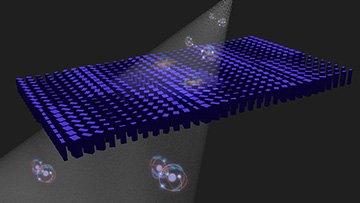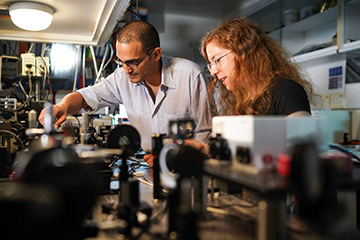
Lead author Kai Wang holding sample of metasurface used in the ANU experiments. [Image Lannon Harley, ANU]
In a pair of recent papers, two different research groups have brought the unique properties of ultrathin dielectric metasurfaces to bear on some problems in quantum information and communications (Science, doi: 10.1126/science.aat8196; 10.1126/science.aat9042).
In one demo, researchers in Australia, Taiwan and the United States teamed up to create a metasurface “camera lens” for use in imaging-based measurements of a photon’s quantum state. And, in the other, an Israel-based group developed a metasurface that’s capable of entangling the spin and orbital angular-momentum states of individual photons as laser light passes through the surface. The two research teams both see significant potential in the use of dielectric surfaces in addressing quantum-optical problems.
Radical downsizing
Dielectric metasurfaces are highly engineered, ultrathin surfaces decorated with arrays of subwavelength scattering elements. They’ve gained a lot of press in recent years for their ability to radically downsize bulk optical elements such as lenses. The researchers behind the first study, led by OSA Fellow Andrey Sukhorukov of the Australian National University (ANU), wanted to see if they could use the tiny metasurfaces to replace the bulk, tabletop-scale beam-splitting optical elements commonly used in experiments to realize quantum interference.
To get there, they started by modeling a metasurface consisting of an array of nanoscale “metagratings,” interleaved in such a way as to spread out individual elliptical polarization states of an input beam into a parallel array of output beams. The outputs, plotted on a Poincaré sphere, can be interpreted as “quantum projections in a multiphoton Hilbert space.” Thus, according to the team, measuring the photon correlations among the output ports allows reconstruction of the quantum density matrix.
Getting quantum interference

Artist’s rendering of the ANU-designed metasurface for quantum measurement and interference. [Image: Kai Wang, ANU]
The team tested out the idea by using standard semiconductor fabrication methods to fashion silicon-on-glass metasurfaces based on the numerical modeling. They then sent heralded single photons (created using spontaneous parametric down-conversion, or SPDC) with different linear polarization states through the surface, capturing the diffracted photon beams via a fiber-coupled interface to single-photon detectors.
The team found that the system allowed the prepared quantum polarization state of the original beam—including amplitude, phase, coherence and quantum entanglement—to be reconstructed from the scattered output beams with 95 percent fidelity. In a separate experiment, the team was able to use the metasurface setup to realize, and measure, quantum interference between multiple photons.
A quantum “camera lens”
The researchers believe these abilities could find use in a variety of areas, including free-space communications and quantum imaging. A key strength of the system, according to the researchers, is that it allows photon correlations and quantum state measurements to be harvested using only polarization-insensitive single-photon click detectors.
Indeed, the team suggests that combining the metasurface with single-photon-sensitive CCD cameras could allow multiple-time-frame images of quantum states. The metasurface is thus analogous to a quantum “camera lens” to allow fast, imaging-based measurements of quantum states.
In addition to Sukhorukov, the research team included other scientists at ANU, the University of New South Wales and the University of Technology Sydney, Australia; the National Central University of Taiwan; and the Oak Ridge National Laboratory, USA.
Entanglement via metasurface

Technion Ph.D. students Elhanan Maguid and Dikla Oren are coauthors on a study on using metasurfaces to create single- and multi-photon entanglement. [Image: Technion]
In a separate set of experiments, a research group at The Technion in Haifa, Israel, led by OSA Fellows Erez Hasman and Mordechai Segev, looked at how metasurfaces might serve in generating and tracking photon quantum-state entanglement in ways useful in quantum information processing. The team’s work focused on the interaction between the spin and orbital angular momentum (OAM) imprinted on individual photons via the action of the metasurface.
The Technion researchers used conventional CMOS fabrication steps to create a silicon-based geometric-phase metasurface. The surface consists of an array of anisotropic antennas “designed to perform as nano half-waveplates.” The structures impart a local delay in the geometric phase of the light passing through (see “Controlling light with geometric-phase holograms,” OPN, February 2016).
In an elegant bit of modeling, the team carefully tailored the orientation of the metasurface structures to simultaneously split out the light’s spin angular momentum (circular polarization) components, and to add a quantity of orbital angular momentum dependent on the sign of the spin state. The result was a metasurface that could take a linearly polarized, zero-OAM input photon and turn it into an output photon with maximally entangled, nonzero spin and OAM states.
Nanophotonics meets quantum optics
The team tested the surface by sending a laser beam through a nonlinear crystal that split individual photons into new photon pairs. Then, they passed one stream of the paired photons through the metasurface, and confirmed, via quantum state tomography, that the interaction with the metasurface had caused the OAM and spin angular momentum states to become entangled within individual photons. Finally, they passed pairs of photons created in the nonlinear crystal through the metasurface—and established that the spin in one photon was entangled with the OAM in the other, and vice versa.
The Technion researchers believe that the ability to use metasurfaces to manipulate entanglement in this way could open up avenues for applying nanophotonics to the quantum information systems of the future. “Our results,” they conclude, “show that metamaterials are suitable for the generation and manipulation of entangled photon states, introducing the area of quantum optics metamaterials.”
